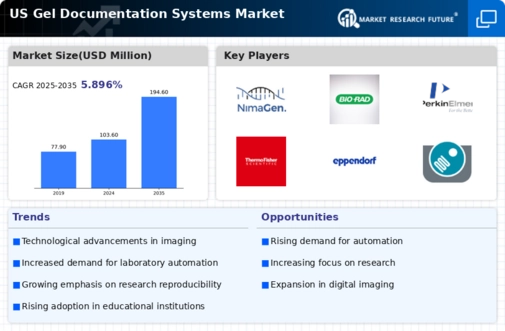The gel documentation-systems market is characterized by a competitive landscape that is increasingly shaped by innovation, strategic partnerships, and technological advancements. Key players such as Bio-Rad Laboratories (US), Thermo Fisher Scientific (US), and GE Healthcare (GB) are at the forefront, each adopting distinct strategies to enhance their market positioning. Bio-Rad Laboratories (US) focuses on expanding its product portfolio through continuous innovation, while Thermo Fisher Scientific (US) emphasizes strategic acquisitions to bolster its technological capabilities. GE Healthcare (GB) appears to be concentrating on digital transformation initiatives, which may enhance operational efficiency and customer engagement. Collectively, these strategies contribute to a dynamic competitive environment, where companies are not only vying for market share but also striving to lead in technological advancements.
In terms of business tactics, companies are increasingly localizing manufacturing and optimizing supply chains to enhance responsiveness to market demands. The market structure is moderately fragmented, with several players competing for dominance. This fragmentation allows for a diverse range of products and services, yet the influence of major players remains significant, as they set benchmarks for quality and innovation that smaller companies often strive to meet.
In October 2025, Bio-Rad Laboratories (US) announced the launch of a new gel documentation system that integrates advanced imaging technology with AI capabilities. This strategic move is likely to position the company as a leader in the market, as it addresses the growing demand for high-resolution imaging and data analysis in research settings. The incorporation of AI may also streamline workflows, making it an attractive option for laboratories seeking efficiency.
In September 2025, Thermo Fisher Scientific (US) completed the acquisition of a leading software company specializing in laboratory automation. This acquisition is expected to enhance Thermo Fisher's product offerings by integrating automation solutions into its gel documentation systems. The strategic importance of this move lies in the potential to provide customers with comprehensive solutions that improve laboratory productivity and data management, thereby reinforcing Thermo Fisher's competitive edge.
In August 2025, GE Healthcare (GB) launched a new cloud-based platform designed to facilitate remote access to gel documentation systems. This initiative reflects a growing trend towards digitalization in the market, allowing researchers to access and analyze data from anywhere. The strategic significance of this development is profound, as it aligns with the increasing demand for flexible and remote laboratory solutions, positioning GE Healthcare as a forward-thinking player in the industry.
As of November 2025, current trends in the gel documentation-systems market include a strong emphasis on digitalization, sustainability, and the integration of AI technologies. Strategic alliances are becoming increasingly important, as companies collaborate to enhance their technological capabilities and market reach. Looking ahead, competitive differentiation is likely to evolve from traditional price-based competition to a focus on innovation, advanced technology, and supply chain reliability. This shift suggests that companies that prioritize these aspects will be better positioned to thrive in an increasingly competitive landscape.





















Leave a Comment